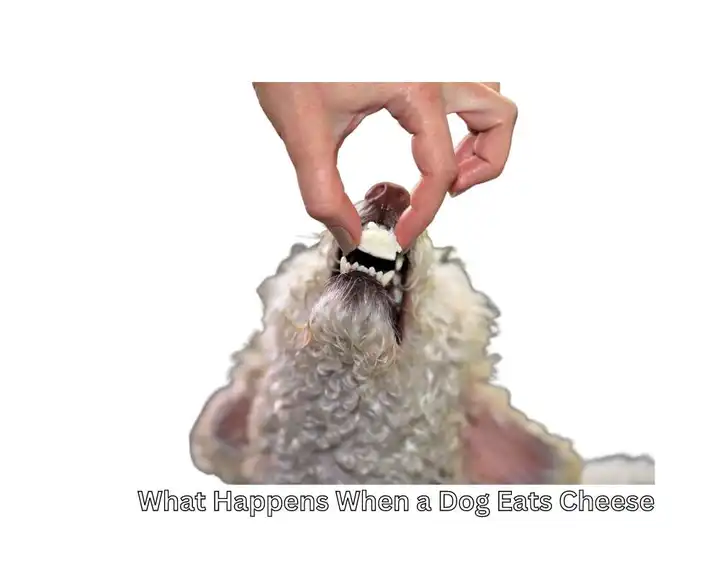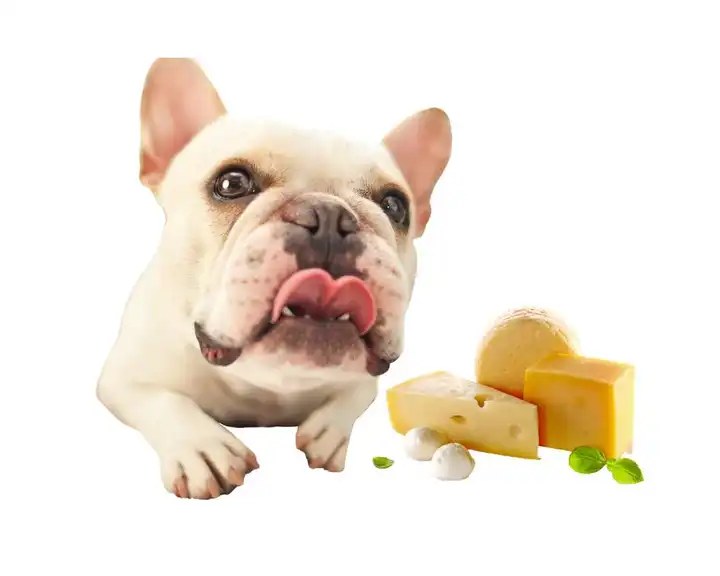What Happens When a Dog Eats Cheese – With its irresistible aroma and creamy texture, cheese has a special place in many households. It’s common for dogs to develop a fondness for this dairy delight, often leading to amusing scenarios of four-legged friends attempting to snatch a piece off the kitchen counter. But what happens when a dog eats cheese? In this article, we’ll delve into the effects and considerations surrounding dogs and their cheese consumption, shedding light on both the positive and negative aspects.

Canine Digestive System and Cheese
A dog’s digestive system is unique and differs from that of humans.
Their digestive tracts are shorter, and they possess certain enzymes that aid in the breakdown of proteins. However, when it arrives to cheese, a typical concern is lactose intolerance. Like some humans, dogs may lack sufficient lactase enzymes to effectively digest lactose, the sugar in milk and dairy products. This intolerance can result in digestive issues when dogs consume cheese.
Nutritional Composition of Cheese
Cheese boasts a variety of macronutrients, including fats, proteins, and carbohydrates. The nutritional composition varies among cheese types, such as cheddar, mozzarella, or Swiss. Fats provide energy and aid nutrient absorption, while proteins contribute to muscle growth and repair. However, it’s crucial to consider cheese’s fat content and caloric density, as excessive consumption can guide to weight gain and related health problems in dogs.
Health Risks Associated with Cheese Consumption
Lactose intolerance is a significant concern for dogs that consume cheese. Symptoms include gas, bloating, runs, and vomiting. Dog owners need to monitor their pets for these signs after cheese consumption. Furthermore, dogs can develop allergic reactions to cheese, manifesting as itching, skin irritation, or gastrointestinal disturbances. If such symptoms arise, consulting a veterinarian is recommended.

Toxicity Concerns: Cheese Types to Avoid
Toxicity concerns related to cheese consumption in dogs are essential to address. While cheese can be a delicious and enjoyable treat, it’s crucial to be aware of certain types of cheese that may be harmful to dogs. Here are some cheese types to avoid:
- Cheeses with Harmful Additives: Some cheeses contain toxic ingredients for dogs. Garlic and onion, commonly found in certain cheeses, can cause damage to a dog’s red blood cells, leading to anemia. It’s essential to read the ingredient labels carefully and avoid cheeses that include these additives.
- High Sodium Cheeses: Certain cheeses, particularly those with increased sodium content, can harm dogs. Excessive sodium intake can lead to salt poisoning or exacerbate health conditions such as heart or kidney problems. It’s best to steer clear of cheeses exceptionally high in sodium.
- Moldy Cheese: Dogs should never consume moldy cheese. It can create mycotoxins, harmful substances that can cause various health issues in dogs. These mycotoxins can impact the dog’s liver and guide to symptoms such as vomiting, diarrhea, tremors, and even seizures. It’s crucial to properly store and discard any cheese that shows signs of mold growth.
- Soft and Fresh Cheeses: Soft cheeses, like Brie or Camembert, and fresh cheeses, such as cottage cheese or ricotta, have higher moisture content, which can create an environment for the growth of bacteria like Listeria or Salmonella. These bacteria can cause foodborne illnesses in dogs. It’s advisable to avoid these cheeses or ensure they are pasteurized before offering them to your dog.
- Flavored or Seasoned Cheeses: Flavored or seasoned cheeses, such as those with herbs, spices, or artificial flavorings, may have components that can be toxic to dogs. Some seasonings, like garlic or certain artificial sweeteners like xylitol, are toxic to dogs and should be strictly avoided. Stick to plain and natural cheeses without counting flavorings or seasonings.
Remember, even if a dog begs for a taste, it’s crucial to prioritize their health and well-being by avoiding potentially harmful cheese types. It’s always a fine idea to confer with a veterinarian if you need clarification on the safety of a specific cheese for your dog. Your veterinarian can provide valuable guidance based on your dog’s requirements and potential sharpness.
As responsible dog owners, we must ensure that our canine companions’ treats are safe and suitable for their consumption. By being aware of the types of cheese to avoid, we can protect our dogs from potential toxicities and promote their overall health and happiness.
Safe Cheese Options for Dogs
When offering to dogs, selecting safe options that are well-tolerated and useful for their health is vital. While not all dogs can handle it due to lactose intolerance or different sensitivities, secure options are known. Here are some recommendations for safe cheese choices for dogs:
- Low-Lactose Cheeses: Dogs with lactose intolerance may even enjoy specific kinds of cheese with a lower lactose range. Hard-aged cheeses like Parmesan or Swiss typically contain less lactose and are nicely accepted by dogs. These can produce a flavorful treat without inducing digestive problems.
- Lactose-Free Cheeses: The lactose is removed or has a lactase enzyme added, allowing lactose breakdown. It confirms that dogs can appreciate the flavor and texture of cheese without the discomfort of digestive problems.
- Goat Cheese: It has less lactose and is suitable for dogs with lactose intolerance. Goat cheese can deliver a creamy and tangy taste that dogs may find irresistible.
- Cottage Cheese: It is a low-fat and protein-rich choice for some dogs. Choosing plain, unsalted cottage cheese without different tastes or seasonings is vital. It cheese can be a healthful complement to a dog’s diet when provided in restraint.
- Homemade Dog-Friendly Cheese Treats: For complete control over the ingredients, consider creating it developed for dogs. Numerous dog-friendly recipes that utilize secure ingredients and are free from potentially dangerous additives are known. These treats can be tailored to your dog’s preferences and dietary needs.
When offering cheese to your dog, always remember the importance of restraint. It should be provided as a rare treat and not as a pin in their diet. Excessive consumption can guide to weight gain and other health troubles. Assessing your dog’s diet and caloric intake is essential when cheese is included in their feeds.
As with any dietary changes, it’s advisable to consult a veterinarian before training or treats to your dog’s diet, particularly if your dog has specific dietary requirements or health conditions. Veterinarians can provide individualized recommendations based on your dog’s needs and ensure that the cheese choices are secure and appropriate for their consumption.
By selecting safe cheese options and rehearsing moderation, you can offer your dog a delectable treat while keeping their health and well-being in mind.
Portion Control and Moderation
When offering to dogs, it is vital. Cheese should be provided as a treat, not a pin, as excessive intake can guide to obesity or nutritional imbalances. Serving sizes should suit the dog’s size and dietary requirements, and goodies should be in moderation. It’s also vital to observe the dog’s response to cheese following any signs of discomfort or intolerance.
Training and Behavioral Considerations
It can be a valuable instrument for exercise and behavioral reinforcement. Its enticing flavor and smell make it an effective positive reinforcement reward during exercise sessions. However, it’s essential not to rely solely on cheese for exercise, as dogs should also remember to react to other commands and cues. Variety in training treats and a balanced approach contribute to a well-rounded training experience.
Cheese and Weight Management
Due to its calorie density, it can contribute to dog weight increase if not properly managed. Dogs that consume excessive amounts of cheese may consume more calories than they need, leading to weight issues and potential health complications. To mix the cheese into a balanced diet, portion control, and calorie counting are key. Regularly monitoring the dog’s weight and body condition can help prevent weight-related problems.
Dental Health and Cheese
Surprisingly, cheese can have dental benefits for dogs. Chewing cheese can stimulate saliva production, which helps cleanse the mouth and reduce plaque buildup. Some types of cheese, rugged and aged varieties, have a texture promoting mechanical teeth cleaning. However, it’s important to note that cheese alone is not a substitute for proper dental care, and regular teeth brushing and professional dental check-ups are still necessary for optimal oral hygiene.
Age Considerations and Cheese Consumption
Age is an essential factor to consider regarding cheese consumption for dogs. Different age groups have varying nutritional needs and considerations. Here’s a closer look at age-related reviews when offering cheese to dogs:
Puppies:
- Developing Digestive System: Puppies have sensitive digestive systems that are still developing. Introducing cheese to a puppy’s diet should gradually allow its digestive system to adapt and avoid potential digestive upsets.
- Limited Lactase Enzyme: Like some human infants, puppies may have reduced lactase levels, the enzyme that helps break down lactose. Many puppies may be lactose intolerant and have difficulty digesting cheese. Observing their tolerance and watching for any signs of digestive issues after consuming cheese is essential.
- Nutritional Balance: Puppies have specific nutritional requirements for growth and development. While cheese can be a source of protein and fats, it should not replace a balanced puppy food diet. Consult with a veterinarian to ensure your puppy’s nutritional needs are met while considering cheese as an occasional treat.
Adult Dogs:
- Maintenance and Moderation: Adult dogs generally have a stable digestive system and can tolerate cheese in moderation. However, it’s essential to consider their diet’s overall calorie intake and nutritional balance. Cheese should be given sparingly and not as a primary food source to avoid excessive calorie consumption and weight gain.
- Individual Sensitivities: Some adult dogs may have specific sensitivities or allergies to certain cheeses. It’s essential to monitor their reactions and adjust the type of cheese offered accordingly. Consult with a veterinarian if you suspect any sensitivities or allergies.
Senior Dogs:
- Age-Related Health Conditions: Senior dogs may have age-related health conditions such as reduced kidney function or dental issues. These factors should be considered when offering cheese as a treat. For example, dogs with kidney problems may require low-sodium cheese options, while those with dental issues may need softer cheese or cheese incorporated into a more delicate treat form.
- Adjusted Portion Sizes: Senior dogs often have lower activity levels and a slower metabolism. It’s essential to adjust the portion sizes of cheese treats to prevent weight gain and maintain a healthy weight. Consult a veterinarian for personalized recommendations based on your senior dog’s health status.
It’s crucial to remember that each dog is unique, and age-related considerations may vary. Consulting with a veterinarian is highly recommended to address any concerns or dietary needs related to age and cheese consumption. Veterinarians can provide guidance tailored to your dog’s circumstances and help ensure the cheese is introduced and incorporated safely into their diet at the appropriate age.
Read Also: How Much to Feed a Puppy by Weight kg

Tips for Introducing Cheese to Dogs
When introducing cheese to dogs, taking a cautious and gradual approach is critical. Here are some essential tips to consider:
- Start with Small Quantities: Begin by offering your dog a tiny piece of cheese. This allows you to gauge their initial reaction and monitor for adverse effects. By giving small, you can observe how your dog’s digestive system responds and ensure they tolerate cheese well.
- Monitor for Digestive Tolerance: After introducing cheese, carefully observe your dog for any signs of digestive issues such as upset stomach, diarrhea, or vomiting. These can be indications of lactose intolerance or other digestive sensitivities. If any negative symptoms occur, it’s essential to discontinue cheese consumption and consult with a veterinarian for guidance.
- Gradually Increase the Amount: If your dog shows no adverse reactions to the initial small piece of cheese, you can gradually increase the serving size over time. Keep an eye on their digestion and overall well-being as you incorporate cheese progressively into their diet.
- Choose the Right Cheese: primarily if your dog is understood to have lactose intolerance. Hard-aged cheeses like Parmesan or certain goat cheeses typically have lower lactose content and are generally better tolerated by dogs. Avoid it with added ingredients, such as garlic or onion, that may harm dogs.
- Consider Allergies: Dogs can develop allergies to various foods, including cheese. Watch for any signs of allergic reactions, such as itching, skin irritation, or gastrointestinal disturbances. If such symptoms occur, discontinue cheese consumption and consult with a veterinarian to determine the cause and appropriate management.
- Balance Cheese with a Healthy Diet: Cheese should be a rare treat, not a proportional diet replacement. Providing your dog with a well-rounded, nutritionally complete meal that meets its specific dietary requirements is vital. Consult your veterinarian to ensure your dog’s diet is balanced and nutritious.
- Seek Veterinary Guidance: Each dog is unique, and their dietary needs may vary based on age, health conditions, and breed. It’s always wise to consult a veterinarian before introducing new foods, including cheese, into your dog’s diet. They can provide personalized recommendations and guidance based on your dog’s needs and health considerations.
Following these tips, you can safely introduce cheese to your dog’s diet and monitor their tolerance and enjoyment of this indulgent treat. Responsible pet ownership involves being attentive to your dog’s requirements and making informed decisions regarding their diet and overall well-being.
Conclusion
In conclusion, cheese can be a tasty and enjoyable treat for dogs, but it’s vital to understand the possible effects and considerations. Lactose intolerance, digestive issues, allergies, and toxicity risks should be considered when offering cheese to dogs.
By choosing safe cheese options, practicing portion control, considering age-related factors, and monitoring the dog’s reactions, pet owners can ensure a positive cheese experience for their furry companions. Responsible pet ownership involves making informed decisions and prioritizing our canine friends’ well-being.



